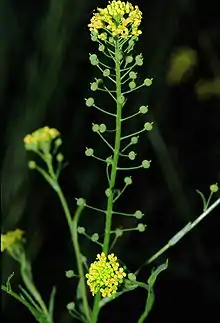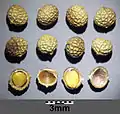| Neslia | |
|---|---|
 | |
| Scientific classification | |
| Kingdom: | Plantae |
| Clade: | Tracheophytes |
| Clade: | Angiosperms |
| Clade: | Eudicots |
| Clade: | Rosids |
| Order: | Brassicales |
| Family: | Brassicaceae |
| Genus: | Neslia Desv. |
| Species: | N. paniculata |
| Binomial name | |
| Neslia paniculata (L.) Desv. | |
| Synonyms | |
|
Myagrum paniculatum L.[1] | |
Neslia is a monotypic plant genus in the family Brassicaceae.[2] The only extant species is Neslia paniculata (L.) Desv.[3]
Neslia paniculata
Neslia paniculata (commonly called ball mustard) is a plant species in the family Brassicaceae. The name comes from the ball-shaped fruits that contain a single seed within an indehiscent fruit coat.[4] It is an annual where the seeds germinate in autumn to winter and grow into a flattened rosette of leaves that develop vertical flowering stems in the spring. These can be up to 1 metre tall. The flowers open in late spring/early summer and the seeds are mature by summer.[5]
It is a native plant of temperate regions of Eurasia.[6] It can also be found in much of the northern and southern regions of the Americas, Australia and also Britain.[7][8] It is considered a weed in many of these regions introduced from agricultural seed and can be a problem in cereal and especially other brassica crops. Its seed pods can contaminate harvests of mustard and rape/canola, even after cleaning. At the other end of the spectrum, within some its original region it has become a threatened or rare arable plant as a consequence of improved agricultural practices.[4]
References
- ↑ "Neslia". Germplasm Resources Information Network. Agricultural Research Service, United States Department of Agriculture. Retrieved 23 January 2018.
- ↑ USDA, NRCS. 2013. The PLANTS Database (http://plants.usda.gov, 2 January 2013). National Plant Data Team, Greensboro, NC 27401-4901 USA.
- ↑ The Germplasm Resources Information Network (GRIN), Genus: Neslia Desv.
- 1 2 Royo-Esnal, Aritz; Gesch, Russell W.; Necajeva, Jevgenija; Forcella, Frank; Edo-Tena, Eva; Recasens, Jordi; Torra, Joel (March 2019). "Germination and emergence of Neslia paniculata (L.) Desv". Industrial Crops and Products. 129: 455–462. doi:10.1016/j.indcrop.2018.12.030.
- ↑ "Ball mustard". Herbiguide. Herbiguide Pty Ltd. Retrieved 1 July 2019.
- ↑ "Neslia paniculata (L.) Desv". Plants of the world online. Royal Botanic Garden Kew Science. Retrieved 1 July 2019.
- ↑ "Plants Profile for Neslia paniculata (ballmustard)". plants.usda.gov. Retrieved 19 February 2020.
- ↑ "Neslia paniculata | Online Atlas of the British and Irish Flora". www.brc.ac.uk. Retrieved 19 February 2020.


